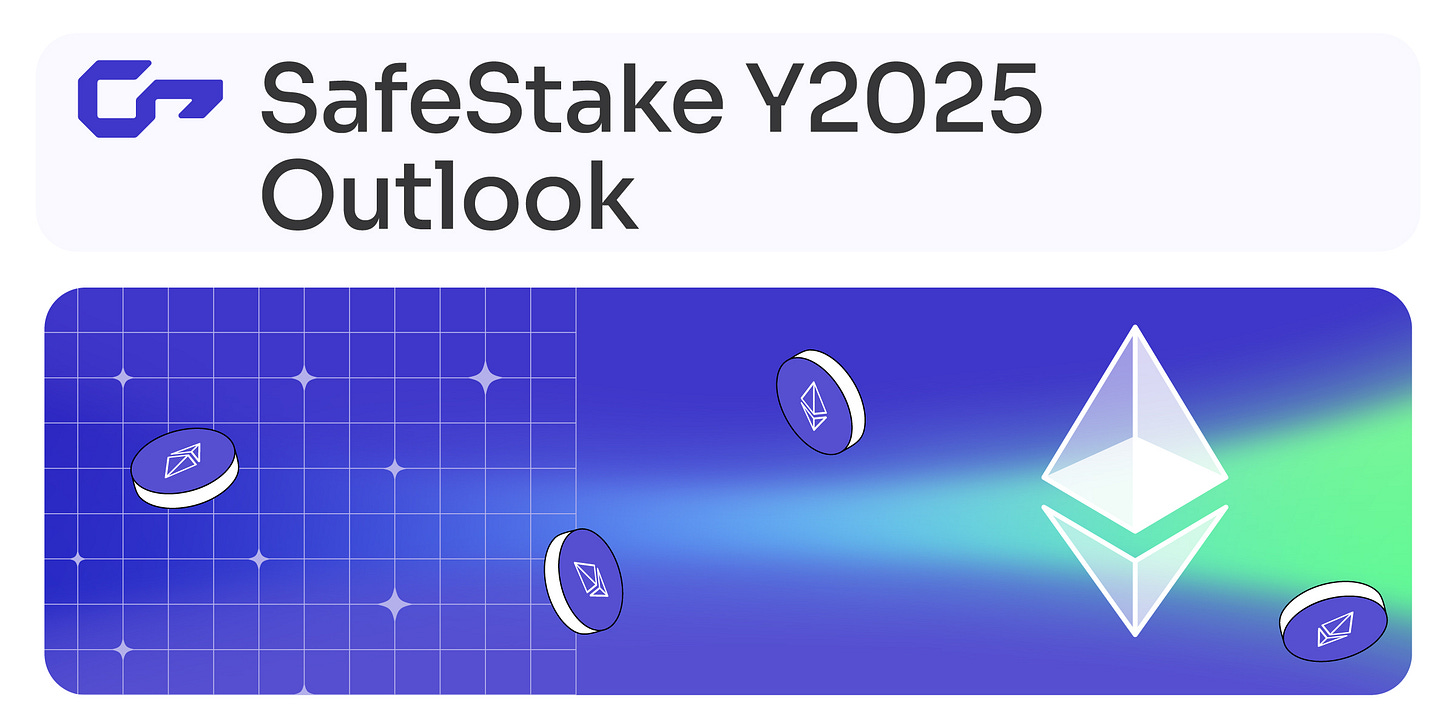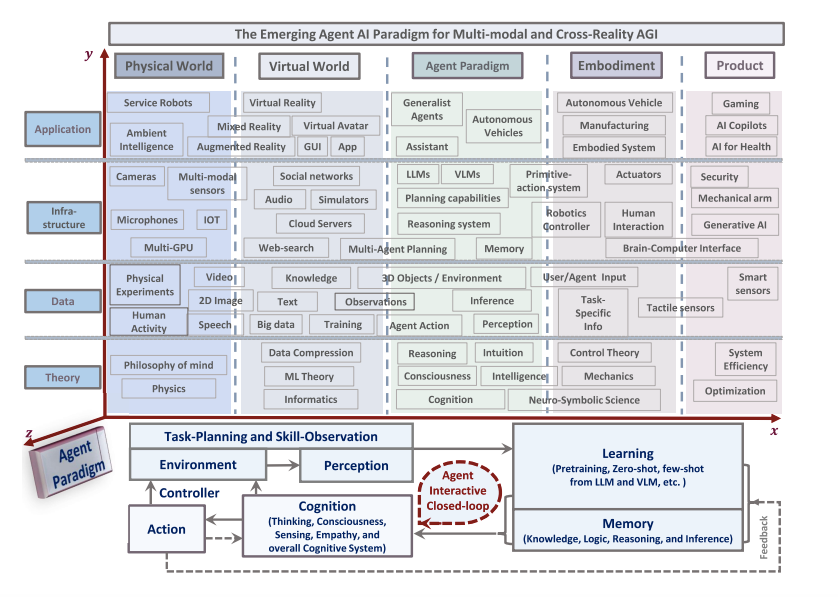SafeStake Y2025 Outlook
Dear Community Members:
Happy New Year!
Before we outline the outlook in Y2025 for SafeStake, we should understand better the trends of Ethereum in the new year.
Ethereum Ecosystem Trends in 2025
EIP Progress
As Ethereum matures in 2025, the implementation of pivotal Ethereum Improvement Proposals (EIPs) is expected to drive transformative changes across the network. Key areas of focus include:
Scalability and Statelessness: The push toward statelessness, through initiatives like EIP-4844 (proto-danksharding), will lower storage requirements for nodes, making participation in the network more accessible and strengthening decentralization. Coupled with advancements in sharding, Ethereum’s scalability will continue to improve, solidifying its position as the backbone for decentralized applications.
MEV Mitigation: The rising prominence of maximal extractable value (MEV) as a challenge to Ethereum’s fairness and user experience is likely to lead to widespread adoption of proposals designed to mitigate MEV. Proposals like PBS (Proposer-Builder Separation) aim to balance the incentives between block proposers and builders while maintaining Ethereum’s decentralization ethos.
Account Abstraction: With the adoption of EIP-4337, account abstraction is reshaping the way users interact with Ethereum. By enabling smart contract wallets with features like social recovery and gas payment flexibility, this proposal is significantly improving accessibility and user experience.
Pectra Upgrades: The upcoming Pectra upgrades introduce several critical updates aimed at enhancing Ethereum's performance and security. Key features include optimized data compression methods to reduce on-chain storage demands and improved cross-chain interoperability frameworks to facilitate seamless communication between Ethereum and other blockchains. These updates are expected to attract a broader developer base and unlock new use cases.
The upcoming Pectra upgrades will be a major milestone. We list the EIPs which will be included in the Pectra upgrades.
1)EIP-7702: Upgrade EOA to Smart Wallets. This EIP upgrades traditional EOA wallets to smart wallets, endowing them with more functions. It enables wallets to combine multiple operations into a single transaction, support conditional payments, and allow others to pay the gas fees on your behalf. It's like the "iPhone moment" for wallets.
2)EIP-2537: BLS12-381 Precompiles. Ethereum has introduced a powerful calculator - the BLS12-381 precompile, which significantly improves the efficiency of complex mathematical operations. This is crucial for ZK technology, privacy protection, and scalability, and also makes the staking system smarter.
3)EIP-2935: Preserve Historical Block Hashes. This EIP allows Ethereum to "remember" more historical data, enabling applications to reference old data from months ago. At the same time, light clients become more useful, laying the foundation for Ethereum's stateless design, that is, nodes no longer need to store everything.
4)EIP-6110: Fix Staking Deposits. Currently, stakers have to wait for a period of time to confirm their deposits. This EIP eliminates this delay, making deposit processing faster and greatly improving the experience of validators.
5)EIP-7002: Enhance Validator Control. Validators will be able to better control their funds, and the decentralization degree of staking pools (such as Lido) and other mechanisms will be significantly improved.
6)EIP-7251: Increase Staking Balance Cap. The staking cap will be raised to 2048 ETH, allowing validators to compound higher rewards. Fewer validators will lead to a clearer network structure and reduce network pressure.
7)EIP-7549: Smarter Validator Voting. At present, validators sign each voting item individually. This EIP reduces the workload by 60 times by merging signatures, while maintaining the same level of security. It's like upgrading from a typewriter to Google Docs collaboration.
8)EIP-7623: Adjust Call Data Costs. The storage of Ethereum blocks is similar to packing luggage, where ordinary transactions are like regular items, and big data calls require more gas fees. This EIP requires big data callers to pay more fees, thereby optimizing network resources.
9)EIP-7685: "Hotline" between Execution Layer and Consensus Layer. Currently, Ethereum's Execution Layer (EL) and Consensus Layer (CL) are like colleagues communicating via email. This EIP establishes a direct "hotline" between them, making future upgrades more efficient and convenient.
10)EIP-7691 + EIP-7840: Improve Blob Handling. Blobs are large data chunks used in Rollups, and currently each block processes 3 Blobs. After the upgrade, it will process 6 Blobs. The result: Rollups become cheaper, expand faster, have lower gas fees, and everyone benefits.
source : @binji_x
Decentralization vs. Institutionalization
The Ethereum ecosystem is navigating a delicate balance between decentralization and growing institutional participation:
Strengthening Decentralization: With the proliferation of distributed validator technologies and an emphasis on geographic and jurisdictional diversity, the staking ecosystem is becoming more resilient. These innovations reduce single points of failure and enhance Ethereum’s censorship resistance.
Institutional Involvement: Institutional players are entering Ethereum staking and DeFi at an accelerated pace, bringing significant liquidity and infrastructure investments. While this influx contributes to the network’s growth and credibility, it also introduces concerns about centralization risks. Community-driven solutions and governance mechanisms are critical to preserving the protocol’s decentralized ethos amidst this trend.
In accordance with the above trends in Ethereum ecosystem, we outline our roadmap in the 1st half year:
Q1, we will continue working with Lido Dao to test our DVT module with Lido’s SDVT module and CSM as well. Hopefully we can get community’s vote to support to integrate with Lido SDVT module in Q2.
Q1, we will support the PreCon protocol Bolt to increase validator yields.
Q2, we will streamline the DKG process and build a private cluster DVT module to target the Institutional clients. Since we expect staked ETH ETF will get approval after Trump takes over the white house. Guess the timeline will be in Q2 too? More and more institutional clients will do ETH staking to generate revenue for the ETF.
Is Quantum computing a threat?
Quantum computing is a very hot topic recently. Is it a threat to Bitcon and ETH? Justin Drake also mentioned Hash-base Signature Scheme will be developed in the next 5 years during DevCon Bangkok in order to solve this threat. If the current ECDSA signature scheme is replaced by the Hash-base Signature, DVT infra will be an end.
Good news is Quantum computing is not a fast threat. Jensen Huang mentioned it will need another 15 years for Quantum computing really scale to be production in his latest interview. This Youtube recording from Ark Invest also elaborates more insights. So, we expect Ethereum Foundation won’t replace the current signature scheme rushly (not in the next 8 years).
Then, it points out SafeStake will only have one OKR in Y2025, which is to get 10% market share in the Ethereum validator base by leveraging our DVT module, to help improving security and resilience of ETH staking.
Broader Crypto Industry Trends in 2025
The convergence of artificial intelligence and blockchain is a defining narrative for 2025:
Decentralized AI Networks: Blockchain’s transparency and security are underpinning decentralized AI marketplaces, enabling the sharing and monetization of AI models and data without reliance on centralized entities.
AI-Powered Smart Contracts: Integrating AI agents with smart contracts is unlocking autonomous decision-making capabilities, enabling applications like predictive resource allocation, dynamic insurance models, and enhanced fraud detection.
Personal AI Agents: Users are deploying personalized AI agents on-chain to manage tasks such as portfolio optimization, DAO voting, and decentralized identity management. These agents leverage blockchain’s security and transparency to ensure alignment with user intent.
We believe Y2025 is the new era of AI Agents. And the project which can be tailored make to improve the AI agent's accuracy, efficiency and security would flip the current top 5 rankings in next cycle. Therefore, we also plan to invest our dev resources, and leveraging our cryptography and TEE expertise to explore the exciting AI agent track when accompanishing all major DVT infra development.
source: https://arxiv.org/pdf/2401.03568
Again, we many thanks the long term support from our community along the journey!
The SafeStake Team.
SafeStake is a decentralized and pioneering technology company focused on revolutionizing Ethereum staking. With its cutting-edge Distributed Validator Technology (DVT), SafeStake provides an ultra-secure, fault-tolerant environment for Ethereum validators to maximize staking rewards and minimize penalties. SafeStake is committed to driving the growth, innovation, and decentralization of the Ethereum network while ensuring the security and prosperity of its participants.






